Scegliere gli inchiostri per serigrafia giusti può fare la differenza nel risultato dei tuoi progetti. Questi inchiostri sono realizzati appositamente per conferire brillantezza, stampe di lunga durata su tutti i tipi di superfici.
Sia che tu stia lavorando con l'abbigliamento, Accessori, o segni, comprendere i tipi di inchiostri è fondamentale per ottenere ottimi risultati.
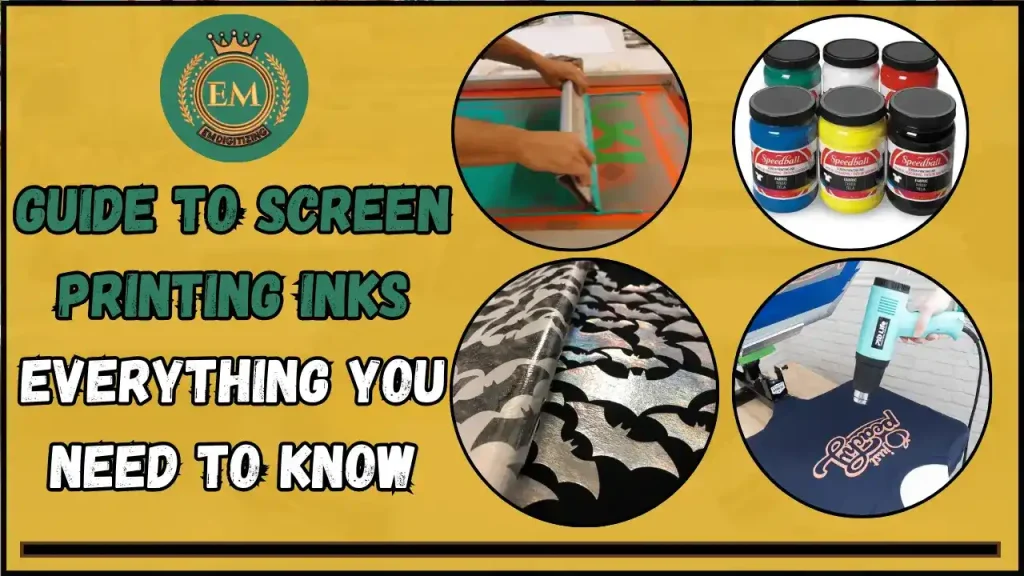
In questa guida, tratteremo le nozioni di base sugli inchiostri per serigrafia, spiegare i loro diversi usi, e aiutarti a decidere quale inchiostro è il migliore per il tuo progetto specifico.
Esploriamo come l'inchiostro giusto può dare vita ai tuoi progetti!
Guida agli inchiostri serigrafici: Tutto quello che devi sapere
Comprendere l'inchiostro serigrafico
È un tipo speciale di inchiostro utilizzato nel processo di serigrafia per trasferire disegni su vari materiali come il tessuto, carta, o metallo. Questo inchiostro è più spesso del normale inchiostro da stampa, permettendogli di creare stampe vivaci e durevoli che possono resistere al lavaggio e alla manipolazione.
Tipi comuni di inchiostri per serigrafia
Esistono vari tipi di inchiostri da stampa, ognuno offre qualità e finiture uniche, quindi è importante scegliere quello giusto in base alle esigenze del progetto e al tipo di tessuto.
- Inchiostro plastisol
- Inchiostro a base d'acqua
- Scaricare l'inchiostro
- Inchiostro per serigrafia a lamina
- Inchiostro metallico
1. Inchiostro plastisol
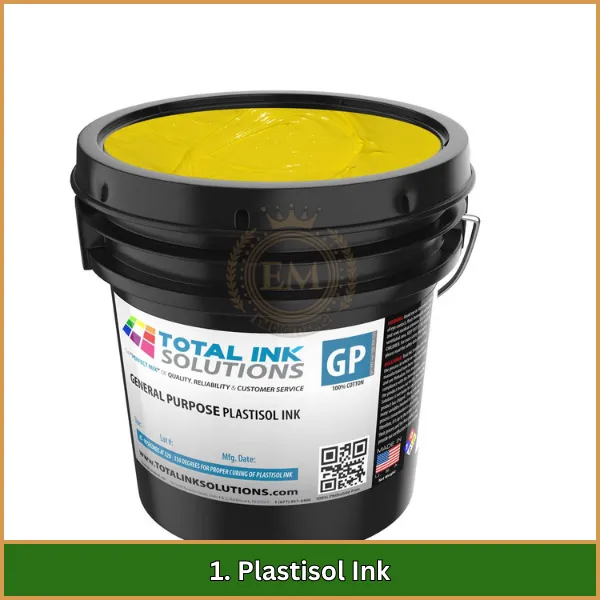
Il plastisol è l'inchiostro serigrafico più comunemente utilizzato nel settore. È spesso, durevole, e ideale per la stampa su vari tessuti. L'inchiostro plastisol rimane sulla superficie del tessuto, fornendo stampe vivaci e di lunga durata. This type of ink is widely used because it doesn’;Non seccarsi sullo schermo, rendendo più facile lavorare per periodi prolungati.
Professionisti:
- Colori vivaci: Gli inchiostri plastisol producono colori brillanti, stampe audaci che si distinguono.
- Durata: Le stampe durano più a lungo e sono altamente resistenti allo sbiadimento, screpolature, o sbucciatura.
- Facilità d'uso: Questo inchiostro è facile da usare e non si asciuga rapidamente, concedendo più tempo per lavorare.
Contro:
- Non traspirante: Plastisol can feel heavy on the fabric and doesn’;t consentire il passaggio di molta aria.
- Preoccupazioni ambientali: Poiché è realizzato in PVC, it’;Non è ecologico come altri tipi di inchiostri.
2. Inchiostro a base d'acqua
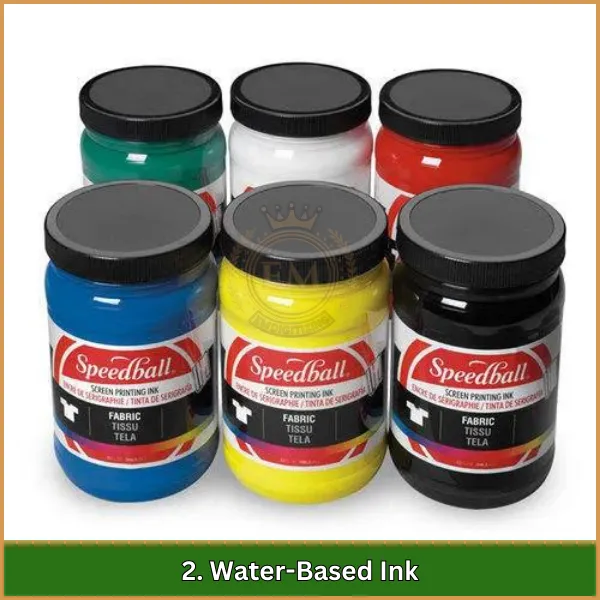
L'inchiostro a base d'acqua utilizza l'acqua come solvente principale anziché i prodotti chimici, rendendolo un'opzione più ecologica. Questo tipo di inchiostri per serigrafia penetrano nel tessuto anziché depositarsi sopra di esso, ottenendo una finitura più morbida. Sono perfetti per ottenere un aspetto naturale, soprattutto su tessuti leggeri.
Professionisti:
- Sensazione morbida: Gli inchiostri a base d'acqua vengono assorbiti dal tessuto, lasciando una stampa leggera e morbida.
- Ecologico: Contengono meno sostanze chimiche nocive e sono più sicuri per l'ambiente rispetto al plastisol.
- Ideale per tessuti leggeri: Questi inchiostri funzionano meglio su materiali di colore chiaro e forniscono una pulizia, finitura liscia.
Contro:
- Limitato ai tessuti scuri: Water-based inks don’;Si manifesta anche sui tessuti scuri a meno che non venga miscelato con additivi speciali.
- Asciugatura rapida: Tendono ad asciugarsi rapidamente sullo schermo, il che può renderli difficili da utilizzare per progetti dettagliati o di grandi dimensioni.
3. Scarica inchiostro

Funziona in modo diverso dalla tradizionale serigrafia a inchiostro. Invece di aggiungere colore al tessuto, rimuove la tintura esistente e la sostituisce con un nuovo colore. Ciò rende l'inchiostro a scarica perfetto per la stampa di disegni luminosi su tessuti scuri, dando l'aspetto dei migliori inchiostri per serigrafia senza sovrapporre troppo inchiostro.
Professionisti:
- Finitura morbida: Come gli inchiostri a base acqua, l'inchiostro di scarico risulta morbido, stampa traspirante.
- Colori vivaci su tessuti scuri: Fornisce un vibrante, colore dall'aspetto naturale su materiali scuri senza aggiungere pesanti strati di inchiostro.
Contro:
- Processo complesso: La stampa a scarica richiede più esperienza e può essere più difficile da controllare.
- Odore chimico: Questo tipo di inchiostro può produrre un forte odore durante il processo di stampa.
4. Serigrafia a lamina
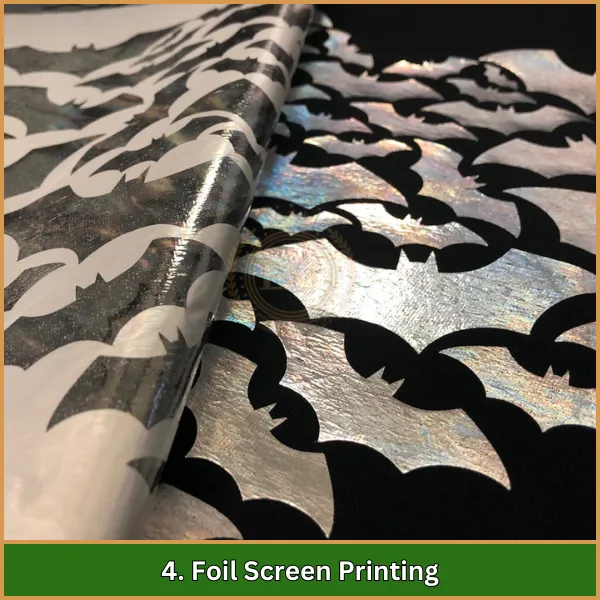
La serigrafia a lamina aggiunge un aspetto metallico lucido agli indumenti utilizzando un sottile foglio di lamina. Il processo inizia stampando l'adesivo sul tessuto e quindi applicando la pellicola sull'adesivo. Il risultato è un riflesso, finitura lucida che conferisce al design un aspetto lussuoso.
Professionisti:
- Finitura lucida: La stampa a foglio offre un effetto sorprendente, aspetto metallico che si distingue, rendendolo perfetto per progetti speciali.
- Aspetto unico: Aggiunge un elemento unico, finitura di fascia alta per i prodotti, rendendoli più attraenti.
Contro:
- Meno resistente: Le stampe su lamina possono rompersi o staccarsi nel tempo, soprattutto con lavaggi o usura frequenti.
- Costo più elevato: È un processo più costoso rispetto ai tradizionali inchiostri serigrafici.
5. Inchiostro metallico
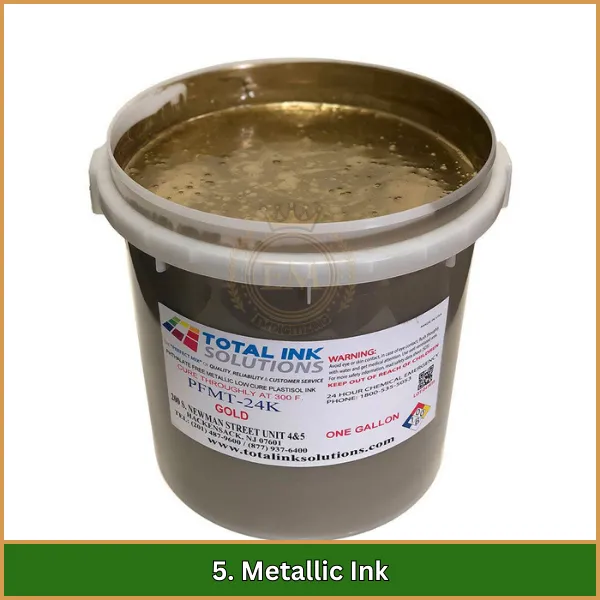
L'inchiostro metallico viene prodotto mescolando piccole particelle metalliche con inchiostro standard, dandogli un aspetto riflessivo, aspetto lucido. Questo miglior inchiostro per serigrafia è comunemente usato per creare effetti speciali o stampe decorative che devono risaltare.
Professionisti:
- Aspetto brillante: L'inchiostro metallico aggiunge un tocco lucido, lucentezza riflettente che rende i disegni accattivanti.
- Durata: Le stampe metalliche tendono a durare più a lungo e mantengono il loro aspetto vibrante.
Contro:
- Inchiostro più denso: Le particelle metalliche rendono l'inchiostro più denso, che può portare a una trama più ruvida sul tessuto.
Uso limitato: L'inchiostro metallico non funziona bene con tutti i tipi di tessuto e potrebbe richiedere tecniche specifiche per l'applicazione.
Fattori da considerare quando si scelgono gli inchiostri serigrafici giusti per il proprio progetto
Scegliere l'inchiostro giusto per la serigrafia implica comprendere diversi fattori chiave per garantire i migliori risultati per il tuo progetto. Ecco gli aspetti importanti da considerare:
1. Tipo di substrato
Il tipo di materiale su cui stai stampando gioca un ruolo significativo nella selezione dell'inchiostro appropriato. L'inchiostro per serigrafia su tessuto come Plastisol funziona bene su cotone e poliestere, mentre gli inchiostri a base acqua sono ideali per le fibre naturali come cotone e seta.
2. Requisiti di progettazione
- Vivacità del colore: Per colori brillanti, gli inchiostri a base acqua sono ottimi per una finitura vibrante. Per tessuti più scuri, Gli inchiostri plastisol forniscono una migliore copertura e opacità.
- Livello di dettaglio: Se il tuo design ha dettagli complessi, gli inchiostri speciali come gli inchiostri metallici o puff potrebbero richiedere tecniche e dimensioni delle maglie specifiche per ottenere i migliori risultati.
3. Metodo di polimerizzazione
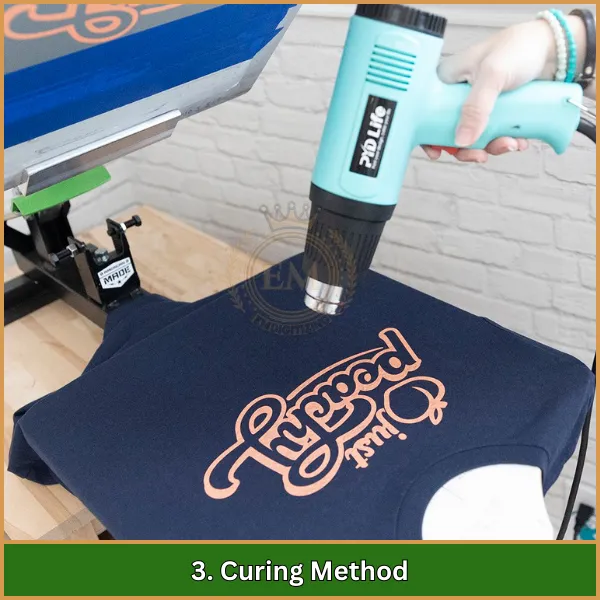
Inchiostri diversi richiedono metodi di polimerizzazione diversi. Gli inchiostri plastisol polimerizzano a temperature più basse, rendendoli adatti a materiali sensibili al calore.
Inchiostri a base acqua, d'altro canto, spesso richiedono temperature più elevate e tempi di polimerizzazione più lunghi.
4. Durabilità e longevità
Quando si sceglie l'inchiostro, considerare quanto tempo deve durare la stampa. Cerca inchiostri resistenti ai raggi UV, umidità, e indossare, soprattutto se l'oggetto sarà esposto agli elementi.
5. Considerazioni ambientali
Se la sostenibilità è importante, selezionare inchiostri a basso contenuto di composti organici volatili (COV) o formulazioni ecologiche per soddisfare le normative ambientali e ridurre l'impronta di carbonio.
6. Costo-efficacia
Considera non solo il prezzo dell'inchiostro ma anche la sua efficienza. Alcuni inchiostri potrebbero avere un costo iniziale più elevato, ma nel lungo periodo consentiranno di risparmiare denaro grazie al minor consumo o alla riduzione degli sprechi.
7. Coerenza del colore
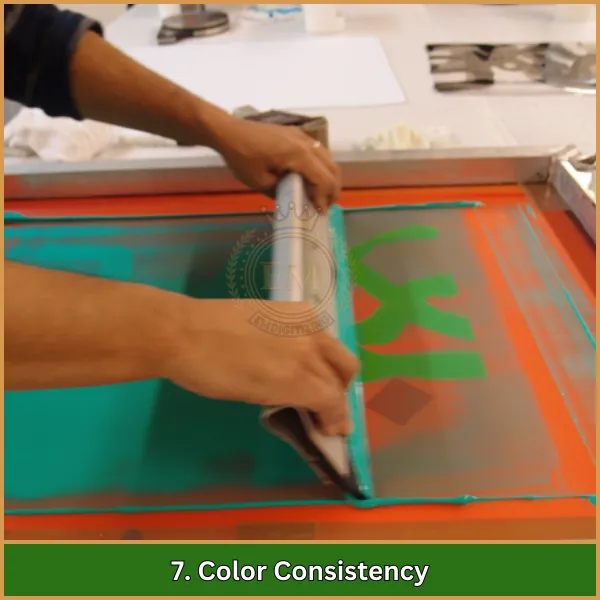
Assicurarsi che l'inchiostro fornisca colori uniformi durante tutte le tirature di stampa. Esegui test di corrispondenza dei colori per garantire che l'inchiostro funzioni bene con il tuo sistema di gestione del colore per ottenere risultati precisi.
Quali sono le applicazioni della serigrafia in diversi settori?
La serigrafia è ampiamente utilizzata in vari settori grazie alla sua versatilità e capacità di produrre stampe di alta qualità. Ecco le principali applicazioni nei diversi settori:
1. Industria dell'abbigliamento
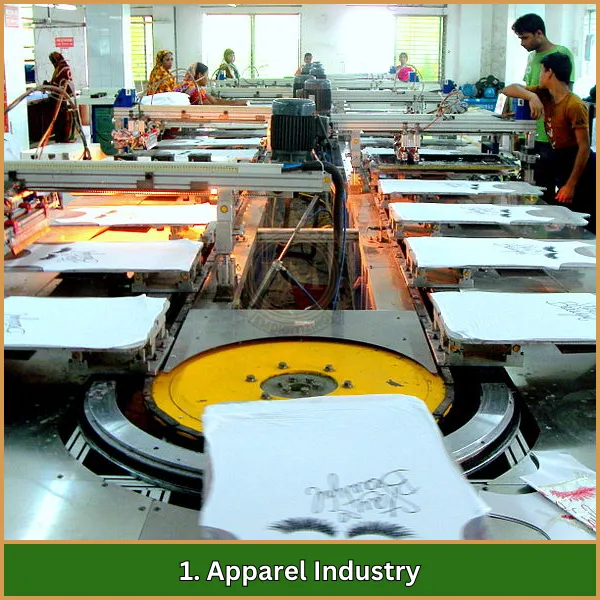
- Magliette e abbigliamento: La serigrafia è comunemente usata per personalizzare le magliette, felpe con cappuccio, e altri indumenti. Gli inchiostri plastisol sono apprezzati per la loro durata e i colori vivaci, rendendoli perfetti per gli indumenti che vengono lavati e indossati frequentemente.
- Abbigliamento promozionale: Le aziende utilizzano la serigrafia per articoli di abbigliamento firmati come uniformi e omaggi perché l'inchiostro garantisce design accattivanti e duraturi.
2. Accessori tessili
- Borse e Berretti: La serigrafia viene utilizzata su accessori come le borse tote, berretti, e calzini, fornendo una qualità costante su diversi materiali.
3. Pubblicità e marketing
- Banner e segnaletica: La serigrafia viene utilizzata per creare banner vivaci, bandiere, e segnaletica per eventi. La durabilità degli inchiostri plastisol li rende ideali per l'uso esterno.
- Espositori per punti vendita: I rivenditori utilizzano la serigrafia per creare display accattivanti che attirano l'attenzione del cliente e promuovono i prodotti.
4. Home decor
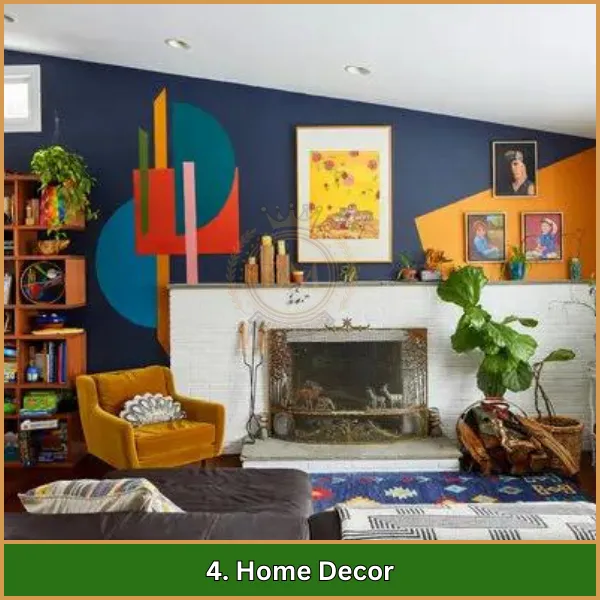
Tessili: La serigrafia viene applicata ai tessuti per la casa come le tende, cuscini, e tovaglie, consentendo disegni personalizzati che valorizzano gli interni domestici.
5. Applicazioni industriali
- Abbigliamento di sicurezza: Negli indumenti di sicurezza vengono utilizzati inchiostri funzionali speciali per garantire un'elevata visibilità e soddisfare gli standard di sicurezza, spesso con proprietà riflettenti.
- Etichette dei prodotti: La serigrafia viene utilizzata per etichette durevoli su prodotti industriali che possono resistere a condizioni difficili.
6. Prodotti Speciali
- Abbigliamento sportivo: Gli inchiostri speciali vengono utilizzati sull'abbigliamento sportivo per fornire flessibilità e traspirabilità mantenendo la vivacità, colori duraturi.
- Articoli promozionali: Gli inchiostri vengono applicati a oggetti come le penne, Portachiavi, e tappetini per mouse per scopi di branding e marketing.
7. Confezione

- Imballaggio alimentare: Inchiostri speciali sono formulati per materiali da imballaggio, garantendo che siano sicuri per il contatto con gli alimenti durante la manutenzione stampe di alta qualità.
Conclusione
In sintesi, selezionare gli inchiostri serigrafici giusti è fondamentale per produrre prodotti di alta qualità, stampe di lunga durata. Conoscendo i vari tipi di inchiostri e le loro applicazioni, puoi assicurarti che i tuoi disegni sembrino vibranti, chiaro, e professionale su qualsiasi materiale. La scelta giusta dell'inchiostro farà una grande differenza nell'aspetto generale e nella durata delle tue stampe.
Per rendere i tuoi disegni ancora più precisi e pronti per la serigrafia, EMDigitalizzazione offre servizi esperti di arte vettoriale. Il nostro team garantisce che la tua opera d'arte sia perfettamente preparata per risultati di stampa nitidi e dettagliati. Più, Come cliente per la prima volta, puoi goderti un 50% sconto sul nostro servizi di arte vettoriale. Approfitta di questa fantastica offerta per migliorare i tuoi progetti di stampa con design di alta qualità!
Domande frequenti
Per pulire l'inchiostro da uno schermo serigrafico, raschiare l'inchiostro in eccesso, quindi utilizzare un detergente per serigrafia o un solvente per emulsione specifico per la serigrafia. Sciacquarlo bene con acqua per rimuovere eventuali residui di inchiostro.
sì, è possibile utilizzare l'inchiostro da stampa per la stampa a blocchi, ma il suo spessore e il tempo di asciugatura potrebbero essere diversi dai normali inchiostri per stampa a blocchi, che potrebbero compromettere la qualità della stampa.
sì, è possibile sovrapporre l'inchiostro serigrafico applicando colori diversi in passaggi separati. Assicurati che ogni strato sia completamente asciutto prima di aggiungere il successivo per evitare che i colori si mescolino.
sì, puoi dipingere con inchiostro da stampa, ma è realizzato specificatamente per la serigrafia, quindi potrebbe non funzionare come le vernici tradizionali su superfici diverse.
